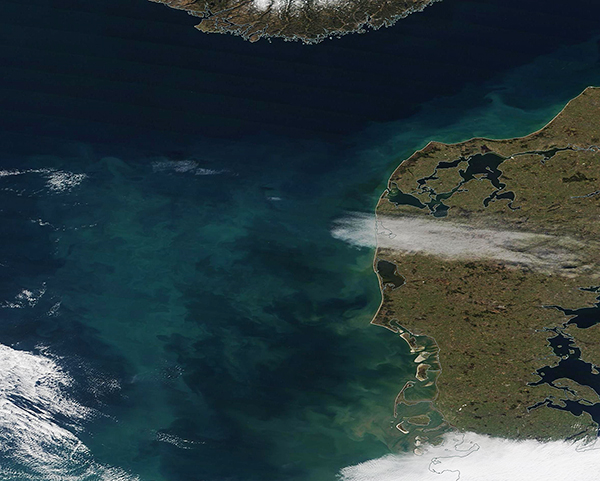Images
March 5, 2023 - Early Bloom in the North Sea
Tweet
The waters of the North Sea were tinted with tones of green and tan in early March 2023. The Moderate Resolution Imaging Spectroradiometer (MODIS) on board NASA’s Terra satellite acquired a true-color image of the colorful scene on March 2.
A bit of cloud wafts over the Denmark in the east and a bit of Norway’s coast can be seen in the north. A halo-like wash of green and tan floats just off the coast of Denmark, while the deeper waters well offshore carry a dark green tint. The near-shore color is almost certainly primarily sediment which has been carried into the North Sea from various rivers or has been washed from the land into the Sea. The deepwater colors, however, are evidence of a bloom of phytoplankton.
Phytoplankton are microscopic organisms that thrive in cold, nutrient-rich waters. They use photosynthesis, like their land-based plant relatives, to convert sunlight into energy. It is the chlorophyll in these organisms that gives them their greenish hue. When these organisms concentrate in enough numbers, the mass (called a “bloom”) can be seen from space.
Blooms of phytoplankton are often seen in the North Sea, typically becoming brightest and most easily seen in late spring and summer. A recent study published in Biogeosciences sampled the waters of the North Sea off of northern Scotland, confirming that phytoplankton numbers remain substantial in even in winter, when light levels are low. Their sampling showed that the spring bloom, which often appears at its most colorful staring in late April or May, is actually initiated just after the winter solstice (late December) as phytoplankton numbers begin to increase. They also found that dominant phytoplankton types changed over annual cycle, with smaller species predominant from November to March and larger species most common during the spring bloom maximum and in summer.
Image Facts
Satellite:
Terra
Date Acquired: 3/2/2023
Resolutions:
1km (213.2 KB), 500m (578.7 KB), 250m (1.1 MB)
Bands Used: 1,4,3
Image Credit:
MODIS Land Rapid Response Team, NASA GSFC
Tweet
The waters of the North Sea were tinted with tones of green and tan in early March 2023. The Moderate Resolution Imaging Spectroradiometer (MODIS) on board NASA’s Terra satellite acquired a true-color image of the colorful scene on March 2.
A bit of cloud wafts over the Denmark in the east and a bit of Norway’s coast can be seen in the north. A halo-like wash of green and tan floats just off the coast of Denmark, while the deeper waters well offshore carry a dark green tint. The near-shore color is almost certainly primarily sediment which has been carried into the North Sea from various rivers or has been washed from the land into the Sea. The deepwater colors, however, are evidence of a bloom of phytoplankton.
Phytoplankton are microscopic organisms that thrive in cold, nutrient-rich waters. They use photosynthesis, like their land-based plant relatives, to convert sunlight into energy. It is the chlorophyll in these organisms that gives them their greenish hue. When these organisms concentrate in enough numbers, the mass (called a “bloom”) can be seen from space.
Blooms of phytoplankton are often seen in the North Sea, typically becoming brightest and most easily seen in late spring and summer. A recent study published in Biogeosciences sampled the waters of the North Sea off of northern Scotland, confirming that phytoplankton numbers remain substantial in even in winter, when light levels are low. Their sampling showed that the spring bloom, which often appears at its most colorful staring in late April or May, is actually initiated just after the winter solstice (late December) as phytoplankton numbers begin to increase. They also found that dominant phytoplankton types changed over annual cycle, with smaller species predominant from November to March and larger species most common during the spring bloom maximum and in summer.
Image Facts
Satellite:
Terra
Date Acquired: 3/2/2023
Resolutions:
1km (213.2 KB), 500m (578.7 KB), 250m (1.1 MB)
Bands Used: 1,4,3
Image Credit:
MODIS Land Rapid Response Team, NASA GSFC




